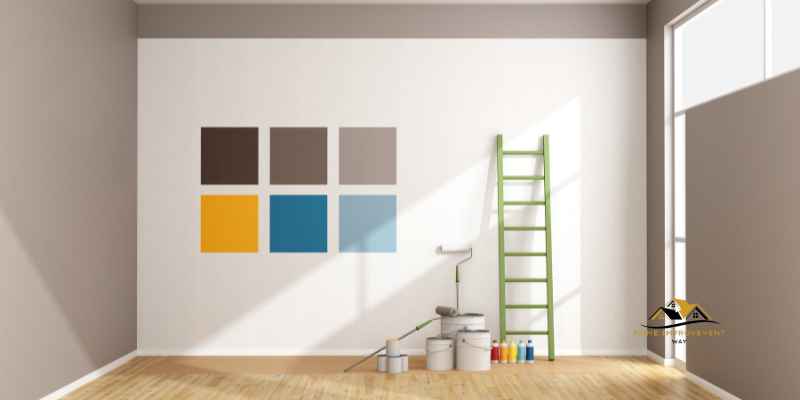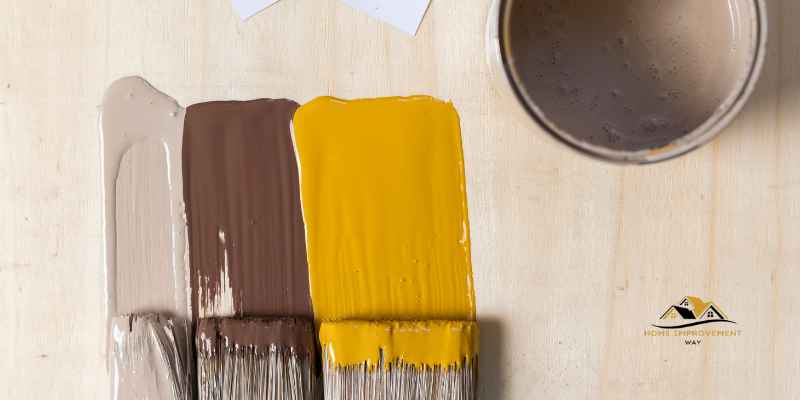When the paint looks darker than on the swatch, it can be due to the number of coats applied and the finish used. Lighting in your space can also affect the appearance of the paint color.
Factors like the size of the sample and surrounding colors can cause variations. Paint color can appear different on the walls due to the interaction of light with the chosen finish. Gloss finishes reflect light and might make the color look darker than expected, while matte or eggshell finishes tend to remain closer to the swatch color.
It’s essential to consider these factors when selecting and applying paint to achieve the desired color outcome in your space.
The Science Of Paint Appearance
Understanding why paint may appear darker than the color swatch is essential. Factors like lighting, color sample size, and surrounding objects influence how we perceive paint colors at home. Scientifically, using multiple coats can also affect the final shade, making it darker than expected.
The Impact Of Lighting On Paint Perception
Lighting plays a pivotal role in how we perceive paint colors. Natural daylight, warm incandescent light, or cool fluorescent light can significantly impact the appearance of paint colors. For example, natural daylight may bring out the truest color, while artificial light sources may alter the perception, resulting in a difference between the swatch and the painted surface. Harsh lighting can make paint appear darker, while softer lighting can lighten it.
Contextual Factors Affecting Paint Color Perception
Contextual factors, including the size of the color sample, the colors of surrounding walls and objects, and even the texture of the surface, can influence how paint colors are perceived. When viewing a small swatch, the perceived color may differ when painted onto a larger surface. Additionally, the color of adjacent walls and objects can reflect onto the paint, altering its appearance. These contextual factors should be considered when choosing and applying paint colors.
Factors Influencing Paint Shade
Paint shades may appear darker than swatches due to factors like lighting and number of coats applied. Context and room lighting can affect color perception, making the shade seem different from the swatch. Using multiple coats can also intensify the color, causing it to look darker than expected.
Effects Of Using A Single Coat Of Paint
Using a single coat of paint may seem like a convenient option to save time and money. However, it can lead to unexpected results. When you apply only one coat of paint, the color may appear lighter than expected, especially if you are using a darker shade. This is because the swatch color is usually achieved by using multiple coats to achieve the desired depth and saturation.
Furthermore, the type of surface you are painting on can also impact the final shade. If the surface has a rough texture or is porous, it may absorb more paint, resulting in a lighter shade. On the other hand, a smooth or primed surface may require fewer coats of paint and can make the color appear closer to the swatch.
Impact Of Using Multiple Coats Of Paint
While using multiple coats of paint can help you achieve a more vibrant and saturated color, it’s important to note that excessive coats can have unexpected consequences. Applying three or more coats of paint may make the shade appear darker than anticipated. This is because each layer of paint adds to the overall thickness and opacity, altering the final color.
Additionally, the sheen of the paint can also affect how the color appears. Higher sheen finishes, such as semi-gloss or gloss, can make the color look darker due to their reflective properties. On the other hand, flat finishes tend to absorb light, making the color appear slightly lighter. So, it’s important to consider the desired sheen level when selecting a paint for your project.
In conclusion, factors like the number of coats used, the surface texture, and the sheen of the paint can significantly influence the final shade. It’s essential to take these factors into account when selecting and applying paint to ensure the color looks as intended.
The Role Of Paint Swatches
Paint swatches play an important role in helping you choose the right paint color, but it’s not uncommon for the actual paint to look darker than it does on the swatch. Factors such as lighting and the number of coats applied can affect the final color outcome.
It’s important to consider these factors when making your decision.
Limitations Of Relying Solely On Paint Swatches
While paint swatches serve as a valuable tool in the color selection process, it’s important to understand their limitations. Paint swatches are small, usually measuring only a few inches in size, which makes it challenging to accurately visualize how the color will appear on a larger scale, such as an entire wall or room. The lighting in the store where the swatches are displayed can also affect how the color appears. Additionally, the surrounding colors and objects in the store can create an optical illusion, making the swatch look different than it would in your own space.
Another limitation of relying solely on paint swatches is that they are often printed on different materials than the actual paint. This means that the texture and finish of the paint may not be accurately represented on the swatch. For example, a swatch may appear matte, but the actual paint could have a gloss or sheen. This discrepancy can significantly impact how the color appears in your space.
Enhancing Color Selection Using Paint Swatches
While paint swatches may have limitations, they can still be a valuable tool in your color selection process when used in conjunction with other methods. To enhance the color selection process, there are a few tips you can follow:
- Take the swatch home: Bring the paint swatch home and hold it up against the wall or surface you plan to paint. This will give you a better idea of how the color will interact with the lighting and other elements in your space.
- Create a sample board: Paint a small section of your wall or a board with the color you are considering. This will allow you to see the color in different lighting conditions throughout the day and assess how it complements your existing decor.
- Consider the finish: Keep in mind that different finishes, such as matte, satin, or glossy, can significantly impact how the color appears. If possible, obtain a sample of the actual paint in the desired finish to get a more accurate representation.
- Consult a professional: If you’re still unsure about selecting the right color, consider consulting with an interior designer or professional painter. They can provide expert advice and help you navigate the color selection process.
Remember, paint swatches are just one tool in your color selection arsenal. By combining them with other methods, you can make a more informed decision and ensure the final color choice looks just as beautiful on your walls as it did on the swatch.
Understanding Different Paint Finishes
When the paint looks darker than the swatch, it could be due to using multiple coats or the presence of artificial lighting. The number of coats used can darken the shade, while various light sources may alter the color’s appearance.
Ensure to test the paint in different lighting conditions to obtain an accurate color representation.
Comparing Flat And Eggshell Finishes
Flat paint has a chalky appearance and absorbs light, which can make a color look slightly lighter. On the other hand, semi-gloss or gloss finishes can make a color look darker due to the reflective sheen.
Effects Of Glossy Finishes On Paint Perception
Choosing between different paint finishes can significantly impact how the color appears on your walls. A glossier finish tends to make the paint appear darker, while a flat finish can make the color seem lighter.
Perception Of Paint Colors Based On Finish
Perception of Paint Colors Based on Finish: The perception of paint colors can be influenced by the type of finish applied. Different finishes such as matte, eggshell, satin, and gloss can alter how a color appears on the wall compared to its swatch.
Differences In Appearance Based On Finish Types
- Matte finish: Can make colors look richer and darker
- Eggshell finish: Reflects more light, causing colors to appear slightly lighter
- Satin finish: Offers a subtle sheen that can enhance deep tones
- Gloss finish: Reflects the most light, making colors appear darker and more vibrant
Choosing The Right Finish To Match Color Perception
When selecting a finish for your paint, it’s essential to consider how it will affect the overall hue of the color. Opting for a matte finish can intensify darker shades, while a gloss finish may deepen and enrich lighter tones.
Maintaining Color Accuracy
To maintain color accuracy when your paint looks darker than the swatch, consider factors like lighting and nearby colors. Using multiple coats of paint can also impact the final shade. It’s essential to test your custom colors and keep in mind that store samples may appear different in various settings.
Paint can sometimes appear darker on your walls than it did on the swatch, leading to unexpected results. Understanding how to maintain color accuracy is essential in achieving the desired look for your space.
Maintaining True Color Representation
- Ensure consistent lighting conditions in the room you are painting.
- Test your chosen paint color on a small area of the wall to see how it appears in different lights.
- Consider the undertones of the color and how they may interact with the lighting.
Tips For Ensuring Consistent Color Match
- Invest in high-quality paint samples to get a more accurate representation of the color.
- Use a primer to create a consistent base for the paint to adhere to.
- Avoid painting over drastically different colors, as this can affect the final shade.
Common Misconceptions About Paint Color

Clarifying Misconceptions About Paint Drying
There is a common misconception that paint always dries to the exact shade on the swatch, but in reality, several factors can influence the drying process, leading to a different appearance than expected. Paint dries as a result of several variables, including the type of paint, the number of coats applied, and the lighting conditions. Understanding these factors can help clarify the myths surrounding paint drying.
Addressing Myths About Paint Color Consistency
Another common misconception is that paint color consistency remains the same regardless of the number of coats applied. However, using too many coats of paint can actually make the color appear darker than expected. Furthermore, variations in lighting and nearby objects can also affect how the paint color is perceived. Addressing these myths surrounding paint color consistency is essential for achieving the expected paint color results.
Expert Insights And Recommendations
Discover why your paint looks darker on the wall than on the swatch. Factors such as lighting and surrounding colors play a role in the final look of your paint job. Consider multiple layers and lighting to ensure your chosen shade matches expectations.
Professional Advice On Paint Selection
Choose the Right Lighting: When selecting paint colors, it is crucial to consider the lighting in the room. Natural and artificial lighting can significantly affect how a paint color appears. To get the most accurate representation, observe the swatch in different lighting conditions to ensure it matches your desired outcome.
Consider Room Size: The size of a room can also impact how a paint color looks. Darker shades tend to make smaller spaces appear even smaller, while lighter colors can create an illusion of openness and brightness. Take into account the dimensions of your room when choosing a color.
Test Samples: Always test paint samples on your walls before making a final decision. Paint a small section of the wall and observe it in various lighting conditions throughout the day. This will give you a better idea of how the color will appear in your specific space.
Best Practices For Achieving Desired Paint Color
Use Primer: Applying a quality primer before painting can help achieve a truer paint color. Primers create a smoother surface for paint and prevent color variations caused by the underlying wall color or texture.
Follow Application Instructions: Each paint brand may have specific instructions for application, including the recommended number of coats and drying time. Following these instructions diligently can help achieve the desired paint color.
Apply Thin Coats: Instead of using thick coats of paint, apply thin, even layers. This technique allows for better control over the color intensity and prevents the paint from appearing darker than expected once dried.
Consider Professional Assistance: If you find it challenging to achieve your desired paint color on your own, consider consulting a professional painter or color consultant. Their expertise can guide you in selecting the right paint shade and application method for your specific needs.

Frequently Asked Questions
Why Does My Paint Look Different Than The Sample?
The paint may look different due to lighting, the size of the sample, and other wall colors. Different finishes can also affect how the color appears.
Why Does My Paint Look Darker?
The paint may look darker due to factors like lighting and the number of coats applied. Lighting and color context in your space can affect how the paint appears. Using multiple coats can result in a darker shade than expected.
Paint swatches are helpful, but not always accurate in determining the final color. Gloss finishes reflect light and may make the paint look darker. Matte or eggshell finishes usually stay true to the chosen color.
How Accurate Are Paint Swatches?
Paint swatches are a useful tool for choosing colors, but they may not always be accurate. Factors like lighting and surrounding colors can affect how a color appears on your walls. Additionally, different finishes can also make a color look darker or lighter.
It’s best to consider other factors and test the color in your own space before making a final decision.
Does Flat Paint Dry Darker Than Eggshell?
Flat paint typically dries slightly lighter than eggshell due to its chalky finish that absorbs light. Semi-gloss or gloss paint can make a color appear darker as their sheen reflects light. Matte or eggshell finishes are usually the most true to color when considering the finish.
Conclusion
To ensure the paint on your walls matches the swatch, consider the impact of lighting and surrounding colors. Experiment with sample patches and various coats to find the perfect shade. Remember, glossy finishes reflect light, making the color appear darker, while matte finishes provide truer hues.
Choose wisely for a harmonious home decor.


